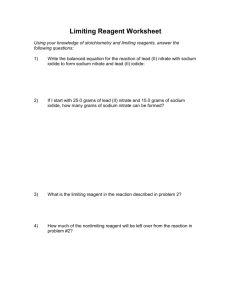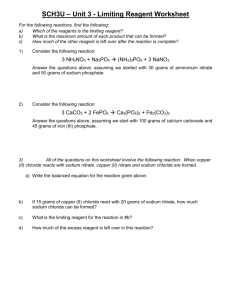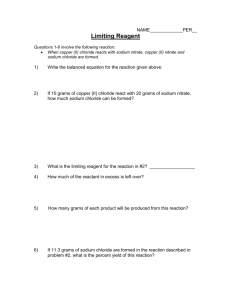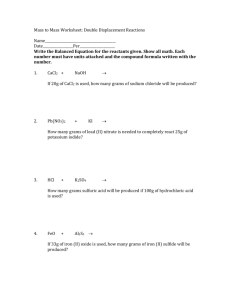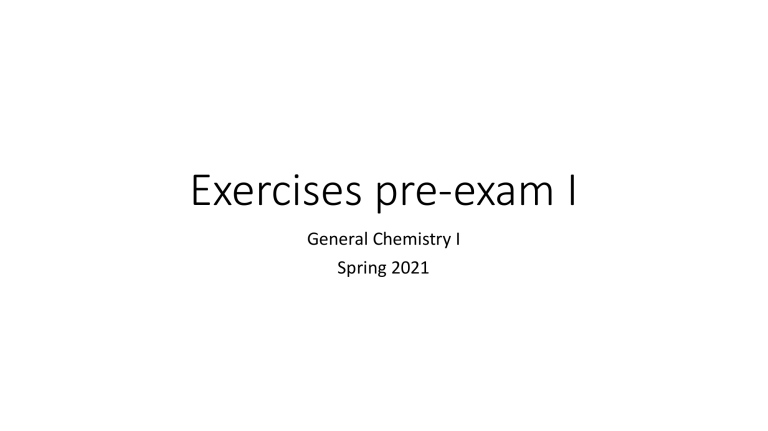
Exercises pre-exam I General Chemistry I Spring 2021 1. A graduated cylinder is weighed and found to have a mass of 48.737 g. A sample of hexane, C6H14, is added to the graduated cylinder, and the total mass is measured as 57.452 g. The volume of the hexane is 13.2 mL. What is the density of hexane? What is the volume of a 2.50 gram block of metal whose density is 6.72 grams per cubic centimeter? (a) 16.8 cubic centimeters (b) 2.69 cubic centimeters (c) 0.0595 cubic centimeters (d) 0.372 cubic centimeters (e) 1.60 cubic centimeters Name the following compounds following the rules explained in class: H2SO4 H2S P2O5 CaSO₄ • 2H₂O ZnCl₂ 2. How many significant figures are there in each of the following? a) 0.006 L, b) 0.0605 dm, c) 60.5 mg, d) 960 x 10-3 g. Circle (or highlight) all of the zeroes in the following numbers which definitely qualify as significant figures. (a) 1020 (b) 102.0 (c) 10.20 (d) 0.201 (e) 2.01 × 102 (f) 1.020 × 102 The formula weight of the compound, Al2(SO4)3 .18H2O (a) 394.4 g/mol (b) 666.4 g/mol (c) 110,900 g/mol (d) 466.8 g/mol (e) 561.2 g/mol What is the mass of oxygen in a 25.0 g sample of TiO2? 5. Carry out the following conversions: a) 68.3 cm3 to cubic meters, b) 7.2 m3 to liters, c) 365 nanometers to km 6. Benzenethiol, C6H5SH, melts at 5.4 °F. What is benzenethiol’s melting point in °C and K? 7. When copper (II) chloride reacts with sodium nitrate, copper (II) nitrate and sodium chloride are formed. a. Write the balanced equation for the reaction given above: CuCl2 + NaNO3 à Cu(NO3)2 + NaCl a. b. c. d. e. If 15 grams of copper (II) chloride react with 20 grams of sodium nitrate, how much sodium chloride can be formed? What is the limiting reagent for the reaction? How many grams of copper (II) nitrate is formed? How much of the excess reagent is left over in this reaction? If 11.3 grams of sodium chloride are formed, what is the percent yield of this reaction? 8. Fill in the gaps in the following table, assuming each column represents a neutral atom. Symbol Protons Neutrons Electrons Mass number 52Cr 55Mn 112Cd 9. Magnesium has three stable isotopes, 24Mg, 25Mg and 26Mg. Their atomic masses and natural abundances are shown below. Calculate the relative atomic mass of magnesium. Isotope Atomic mass (amu) Natural abundance (%) 24Mg 23.9850 78.99 25Mg 24.9858 10.00 26Mg 25.9826 11.01 How many carbon atoms are in 115.00 g of glucose, C6H12O6? a. 115 b. 6.02x1023 c. 0.638 d. 3.84x1023 e. 2.31x1024 A compound containing carbon and hydrogen contains 4.75 g of carbon and 0.80 g of hydrogen. The molar mass of the compound is about 28 g/mol. What is (a) the empirical formula of the compound and (b) the molecular formula of the compound? Balance, if necessary, the following chemical equations: (a) Pb(NO3)2 + NaCl ® PbCl2 + NaNO3 (b) C2H5OH + O2 ® H2O + CO2 (c) CCl4 + SbF3 ® CCl2F2 + SbCl3 When lead (II) nitrate reacts with sodium iodide, sodium nitrate and lead (II) iodide are formed. Pb(NO3)2 (aq) + NaI (aq) à PbI2 (s) + NaNO3 (aq) a. If I start with 25.0 grams of lead (II) nitrate Pb(NO3)2 and 15.0 grams of sodium iodide NaI, how many grams of sodium nitrate NaNO3 can be formed? b. What is the limiting reagent in the reaction? c. How many grams of lead (II) iodide PbI2 is formed? d. How much of the non-limiting reagent will be left over from the reaction? e. If 6 grams of sodium nitrate NaNO3 are formed in the reaction, what is the percent yield of this reaction?


